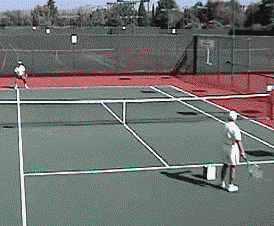|
TennisOne QuickTips
QuickTip: Return of Serve Hank Pfister
It is said that tennis is about movement and hitting, and indeed the best players are both quick on their feet and skillful hitters. But within the subset of hitting skills, including forehand, backhand, serve and volley, the return of serve is generally the most overlooked, the least practiced, yet somehow the most important. If you cannot get the return of serve in play, your movement, your tactics, your mental toughness, are all for naught. And before you address spin, placement, or power on this return of serve, the number one priority is consistency – reliably getting the return in play again and again and again. From my teaching point of view – the most common problem with the return of serve at all levels of play is simply inconsistency. So, what is the solution? To be an effective returner you have to do three things:
Square your body to face the server In preparing to receive serve, many players incorrectly line up their feet just behind or in front of the baseline, with their shoulders and body parallel to that baseline. The proper ready position is to place the feet and body such that your chest and body are directly facing the server. From this position, you can move just as easily to your forehand or backhand to cut off the angle of the serve. Move forward and to the ball As the server's ball toss goes up, start moving forward. Go towards the ball (unless the serve is a body-jam shot) to cut off the angle and to use the forward shift of your body momentum to generate power on the return. How do you know if you are moving forward enough? If you've moved forward properly on the first serve and the server has missed, you'll find you have to retreat a few steps to prepare for the second serve. Use a short or restricted back swing To learn how to return with a short or restricted back swing, take your racquet back about a foot or two from the ready position. Without moving the racquet any further with your arm, use your shoulder turn to take the racquet back further and complete your back swing. By using a restricted back swing; you'll find you can time the return of serves much better.
How to practice Get a bucket of balls and have your practice partner hit serves from the mid-court. Start by receiving on the deuce court. The server stands on the mid-court and serves 10-20 balls to the forehand side. Once you return 8 balls in a row successfully, repeat the same drill to your backhand. If you want to get creative, have your practice partner serve randomly. Work on this drill 1-3 times a week, and Return-of-Serve will become one of the strengths of your game. Your comments are welcome. Let us know what you think about Hank Pfister's article by emailing us here at TennisOne. |

